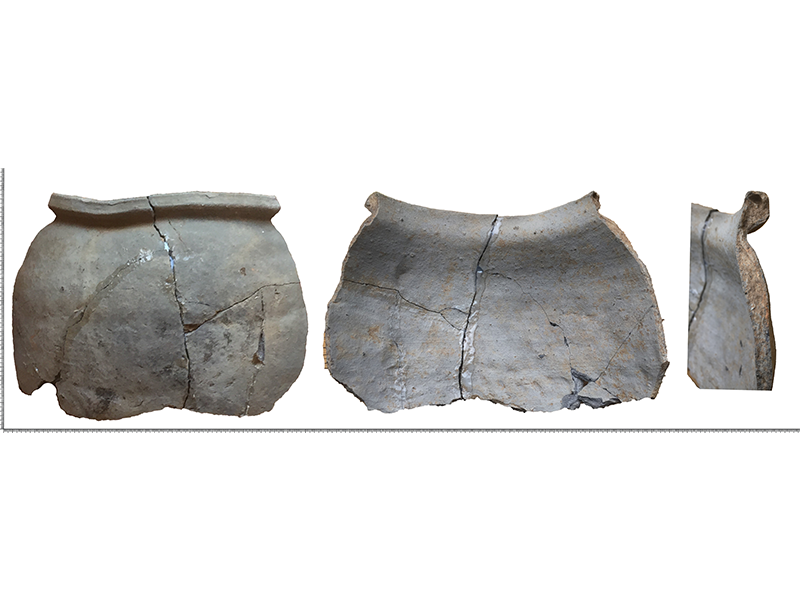See Archaeological Treasures Unearthed by U.K. Residents During Lockdown
Finds include a Neolithic arrowhead, a snake-shaped belt hook and shards of Roman pottery
:focal(377x293:378x294)/https://tf-cmsv2-smithsonianmag-media.s3.amazonaws.com/filer/c4/70/c4707745-9f5c-4027-9d0c-f10e4264e10a/snake.png)
People across the United Kingdom have discovered an array of archaeological artifacts while tending to their gardens during lockdown, reports Aaron Walawalkar for the Guardian.
So far, finds cataloged by the British Museum’s Portable Antiquities Scheme (PAS), which seeks “to encourage the recording of archaeological objects found by members of the public in England and Wales,” include a Neolithic arrowhead, a silver medieval coin and fragments of Roman pottery.
“With so many people spending so much more time in their gardens, there have been some really interesting finds,” finds liaison officer Peter Reavill tells Sherna Noah of the British Press Association (PA). “I’ve seen some tobacco pipes, some pieces of pottery and even prehistoric flint tools found in people’s gardens.”
Reavill adds, “People find stuff all the time, and put it on one side and say, ‘That’s interesting, I’ll do something with that.’ But they’ve had the time now to get in touch and say, ‘I found this. What is it?’”
From a serpentine hook to an intricately decorated ring, these are some of the most exciting finds.
/https://tf-cmsv2-smithsonianmag-media.s3.amazonaws.com/filer/61/72/617230cd-d565-4b6c-b552-c1692d69a08c/e61bceb198a72507b02f1d8c0855eeae.jpg)
According to the Sun, an individual in Chithurst, West Sussex, found a Neolithic arrowhead in their garden.
In Herefordshire, meanwhile, one resident encountered a snake-shaped belt hook dated to the post-medieval period. Another local spotted a late medieval ring on top of a molehill.
In Stoke-on-Trent, Staffordshire, a person digging beneath their lawn unearthed a silver coin minted during the reign of Edward III. Another medieval coin cataloged by the scheme dates to 1430 or 1431 and bears Henry VI’s likeness. A resident of Fareham, Hampshire, found the silver groat in their garden.
A sandstone rock featuring Ogham script was found in Coventry. The ancient Ogham alphabet appears on stone monuments throughout the U.K. and was used to write inscriptions in Archaic and Old Irish, Old Welsh, Pictish, and Latin. Researchers are currently awaiting a translation of the text, which is thought to date to the fourth century A.D., Teresa Gilmore, a finds liaison officer with the Birmingham Museums Trust, tells Smithsonian magazine via email.
Previously, the area in which the stone was unearthed has produced little in the way of early medieval artifacts, says Gilmore. She adds that examples of Ogham scripts are relatively rare; around 20 have been found in the U.K. to date.
Per the PA, another U.K. resident stumbled upon a Neolithic or Bronze Age quern—used to grind grain, the tool consists of two circular stones—near Bradford, West Yorkshire.
Eight fragments of Roman greyware pottery were uncovered in Wymeswold, Leicestershire, according to the Guardian.
/https://tf-cmsv2-smithsonianmag-media.s3.amazonaws.com/filer/20/48/20482c82-ae45-46fe-a0d8-0164f777cd78/swyorc3a26eneolithicquern.jpg)
“During the period of total lockdown, a number of garden finds have come to light as people have been digging their gardens whilst off work or unable to go out as much as usual,” Michael Lewis, head of portable antiquities and treasure at the British Museum, tells the PA. “Finders can be shy about showing finds liaison officers their garden finds, but we are keen to see what is discovered by the public. Often people don’t realize the archaeological significance of what they find.”
U.K. residents who discover objects that may be of interest are urged to notify the British Museum’s PAS. Lewis adds that most finders get to keep their treasures.
Reavill tells the PA that the uptick in finds is one of the unexpected silver linings of the lockdown.
“People have had time to consider where they are and who have gone before them—most importantly they have had the time to get in touch with their discoveries,” he says.
/https://tf-cmsv2-smithsonianmag-media.s3.amazonaws.com/accounts/headshot/alex.png)
/https://tf-cmsv2-smithsonianmag-media.s3.amazonaws.com/filer/b4/f7/b4f7a668-46f3-4be5-b7aa-d611cb385040/wmid-634a9a.jpg)
/https://tf-cmsv2-smithsonianmag-media.s3.amazonaws.com/filer/68/c1/68c108bd-b092-430d-99f0-3a1457f15d0f/hamp0cb631.jpg)

/https://tf-cmsv2-smithsonianmag-media.s3.amazonaws.com/accounts/headshot/alex.png)